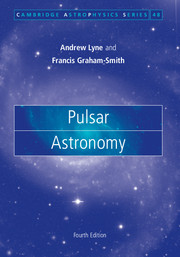Book contents
- Frontmatter
- Contents
- List of illustrations
- Preface
- 1 The discovery of pulsars
- 2 Neutron stars
- 3 Telescopes and techniques
- 4 The distances of the pulsars
- 5 Pulsar timing
- 6 Timing and astrometry of binary pulsars
- 7 Timing irregularities
- 8 The Galactic population of pulsars
- 9 The Crab and Vela Pulsars
- 10 Other young pulsars
- 11 Millisecond and binary pulsars
- 12 Accretion-powered X-ray pulsars
- 13 Magnetars
- 14 Supernovae and their remnants
- 15 Integrated pulse profiles
- 16 Individual pulses
- 17 Location of emitting regions
- 18 Radiation processes
- 19 The emission mechanisms
- 20 Interstellar scintillation and scattering
- 21 The interstellar magnetic field
- 22 Achievements and prospects
- References
- Index
11 Millisecond and binary pulsars
Published online by Cambridge University Press: 05 March 2012
- Frontmatter
- Contents
- List of illustrations
- Preface
- 1 The discovery of pulsars
- 2 Neutron stars
- 3 Telescopes and techniques
- 4 The distances of the pulsars
- 5 Pulsar timing
- 6 Timing and astrometry of binary pulsars
- 7 Timing irregularities
- 8 The Galactic population of pulsars
- 9 The Crab and Vela Pulsars
- 10 Other young pulsars
- 11 Millisecond and binary pulsars
- 12 Accretion-powered X-ray pulsars
- 13 Magnetars
- 14 Supernovae and their remnants
- 15 Integrated pulse profiles
- 16 Individual pulses
- 17 Location of emitting regions
- 18 Radiation processes
- 19 The emission mechanisms
- 20 Interstellar scintillation and scattering
- 21 The interstellar magnetic field
- 22 Achievements and prospects
- References
- Index
Summary
A distinct population
The millisecond pulsars are in a different category from the general population of ‘normal’ pulsars. The majority of pulsars are following a simple course of evolution, from a birth in a supernova, through a slowdown from a rotational period at birth of some tens of milliseconds to a death at around one second when the radiation ceases or becomes undetectable. The millisecond pulsars constitute a separate and much longer-lived population, which originate from the general population of normal pulsars as the result of gravitational interactions with binary partners; most still have their companions, but some have lost them or are possibly in the process of losing them, thus becoming solitary millisecond pulsars.
Most millisecond pulsars have rotational periods less than 10 ms, although a more useful definition includes periods up to 30 ms. Figure 11.1 shows their position in the P/Ṗ diagram, which also shows all known binary systems as circles. Although there is a distinct gap between normal and binary pulsars in this diagram, there are some pulsars within the gap; most of these have the characteristics of millisecond pulsars such as a comparatively low slowdown rate, and they have probably experienced the same binary interactions.
Binary stars
It is remarkable that almost all of the neutron stars associated with X-ray sources are members of binary systems, while only one in ten of the radio pulsars is a binary.
- Type
- Chapter
- Information
- Pulsar Astronomy , pp. 151 - 169Publisher: Cambridge University PressPrint publication year: 2012

